Label: SOFDRA- sofpironium bromide gel
- NDC Code(s): 83723-010-50
- Packager: Botanix SB Inc.
- Category: HUMAN PRESCRIPTION DRUG LABEL
- DEA Schedule: None
- Marketing Status: New Drug Application
Drug Label Information
Updated September 22, 2025
If you are a consumer or patient please visit this version.
- Download DRUG LABEL INFO: PDF XML
- Official Label (Printer Friendly)
-
HIGHLIGHTS OF PRESCRIBING INFORMATION
These highlights do not include all the information needed to use SOFDRA™ safely and effectively. See full prescribing information for SOFDRA.
SOFDRA (sofpironium) topical gel, 12.45%
Initial U.S. Approval: 2024INDICATIONS AND USAGE
SOFDRA is an anticholinergic indicated for the treatment of primary axillary hyperhidrosis in adults and pediatric patients 9 years of age and older ( 1).
DOSAGE AND ADMINISTRATION
Apply 1 pump of SOFDRA per underarm once a day at bedtime. For topical use only ( 2).
DOSAGE FORMS AND STRENGTHS
Topical gel: 12.45% of sofpironium ( 3).
CONTRAINDICATIONS
Medical conditions that can be exacerbated by the anticholinergic effect of SOFDRA (e.g., glaucoma, paralytic ileus, unstable cardiovascular status in acute hemorrhage, severe ulcerative colitis, toxic megacolon complicating ulcerative colitis, myasthenia gravis, Sjögren's syndrome) ( 4).
WARNINGS AND PRECAUTIONS
- Urinary Retention:Use with caution in patients with a history or presence of documented urinary retention. Discontinue use immediately and consult a healthcare provider should any signs or symptoms of urinary retention develop ( 5.1).
- Control of Body Temperature:Watch for generalized lack of sweating when in hot or very warm environmental temperatures and avoid using SOFDRA if not sweating under these conditions ( 5.2).
- Operating Machinery or an Automobile:Transient blurred vision may occur with use of SOFDRA. If blurred vision occurs, discontinue use and avoid operating a motor vehicle or other machinery until symptoms resolve ( 5.3).
ADVERSE REACTIONS
Most common adverse reactions (incidence ≥2%) are dry mouth, vision blurred, application site pain, application site erythema, mydriasis, application site dermatitis, application site pruritus, urinary retention, and application site irritation ( 6.1).
To report SUSPECTED ADVERSE REACTIONS, contact Botanix SB Inc. at 1-866-763-6337 or FDA at 1-800-FDA-1088 or www.fda.gov/medwatch.
DRUG INTERACTIONS
- Anticholinergics:Coadministration of SOFDRA with anticholinergic medications may result in additive interaction leading to an increase in anticholinergic adverse effects. Avoid coadministration of SOFDRA with other anticholinergic-containing drugs ( 7.1).
- Strong Inhibitors of CYP2D6:Avoid co-administration of SOFDRA with drugs that are strong inhibitors of CYP2D6 ( 7.2).
See 17 for PATIENT COUNSELING INFORMATION and FDA-approved patient labeling.
Revised: 7/2025
-
Table of Contents
FULL PRESCRIBING INFORMATION: CONTENTS*
1 INDICATIONS AND USAGE
2 DOSAGE AND ADMINISTRATION
3 DOSAGE FORMS AND STRENGTHS
4 CONTRAINDICATIONS
5 WARNINGS AND PRECAUTIONS
5.1 Urinary Retention
5.2 Control of Body Temperature
5.3 Operating Machinery or an Automobile
6 ADVERSE REACTIONS
6.1 Clinical Trials Experience
7 DRUG INTERACTIONS
7.1 Anticholinergics
7.2 Strong Inhibitors of CYP2D6
8 USE IN SPECIFIC POPULATIONS
8.1 Pregnancy
8.2 Lactation
8.4 Pediatric Use
8.5 Geriatric Use
8.6 Renal Impairment
8.7 Hepatic Impairment
10 OVERDOSAGE
11 DESCRIPTION
12 CLINICAL PHARMACOLOGY
12.1 Mechanism of Action
12.2 Pharmacodynamics
12.3 Pharmacokinetics
13 NONCLINICAL TOXICOLOGY
13.1 Carcinogenesis, Mutagenesis, Impairment of Fertility
14 CLINICAL STUDIES
16 HOW SUPPLIED/STORAGE AND HANDLING
17 PATIENT COUNSELING INFORMATION
- *
- Sections or subsections omitted from the full prescribing information are not listed.
- 1 INDICATIONS AND USAGE
-
2 DOSAGE AND ADMINISTRATION
- Do not shave armpits at least 8 hours before applying SOFDRA.
- Do not shower at least 30 minutes before applying SOFDRA.
- Apply SOFDRA to clean, dry skin once a day at bedtime.
- Apply a single pump actuation to the top of the supplied applicator. Spread the entire amount to cover 1 underarm. Apply a separate, single pump actuation to the top of the supplied applicator. Apply the entire amount to the second underarm. Allow to dry completely (5 minutes) before putting on clothing.
- Wash hands immediately with soap.
- For topical use only.
- Avoid fire, flame, and smoking during and immediately following application.
- Do not shower or wash underarms for at least 8 hours after application.
- Do not touch underarms after applying SOFDRA.
- Do not use more than once daily.
- Avoid transfer of SOFDRA to the periocular area [see Warnings and Precautions (5.3)] .
- Do not apply SOFDRA to broken skin.
- Avoid using SOFDRA with occlusive dressings.
- 3 DOSAGE FORMS AND STRENGTHS
-
4 CONTRAINDICATIONS
SOFDRA is contraindicated in patients with medical conditions that can be exacerbated by the anticholinergic effect of sofpironium bromide (e.g., glaucoma, paralytic ileus, unstable cardiovascular status in acute hemorrhage, severe ulcerative colitis, toxic megacolon complicating ulcerative colitis, myasthenia gravis, Sjögren's syndrome).
-
5 WARNINGS AND PRECAUTIONS
5.1 Urinary Retention
Use SOFDRA with caution in patients with a history or presence of documented urinary retention. Prescribers and patients should be alert for signs and symptoms of urinary retention (e.g., difficulty passing urine, distended bladder), especially in patients with prostatic hypertrophy or bladder-neck obstruction. Discontinue use immediately and consult a healthcare provider should any of these signs or symptoms develop.
5.2 Control of Body Temperature
In the presence of high ambient temperature, heat illness (hyperpyrexia and heat stroke due to decreased sweating) can occur with the use of anticholinergic drugs, including SOFDRA. Watch for generalized lack of sweating when in hot or very warm environmental temperatures and avoid using SOFDRA if not sweating under these conditions.
5.3 Operating Machinery or an Automobile
Transient blurred vision may occur with use of SOFDRA. If blurred vision occurs, discontinue use and avoid engaging in activities that require clear vision, such as operating a motor vehicle or other machinery or performing hazardous work, until the symptoms have resolved.
-
6 ADVERSE REACTIONS
The following clinically significant adverse reactions are described elsewhere in the labeling:
Urinary Retention [See Warnings and Precautions (5.1)].
6.1 Clinical Trials Experience
Because clinical trials are conducted under widely varying conditions, adverse reaction rates observed in the clinical trials of a drug cannot be directly compared to rates in the clinical trials of another drug and may not reflect the rates observed in practice.
In two double-blind, vehicle controlled clinical trials (CARDIGAN 1 and CARDIGAN 2) of 700 subjects 10 to 76 years of age (353 subjects treated with SOFDRA and 347 subjects treated with vehicle), 44% of subjects were male, 79% were White, 21% were Black, and 1% were Asian. A total of 618 subjects completed at least 6 weeks of treatment, including 307 subjects treated with SOFDRA and 311 subjects treated with vehicle.
Table 1 summarizes the most frequent adverse reactions (≥2%) in subjects with primary axillary hyperhidrosis treated with SOFDRA.
Table 1: Adverse Reactions Occurring in ≥2% of Subjects with Primary Axillary Hyperhidrosis Treated with SOFDRA in Trials CARDIGAN 1 and 2 Adverse Reactions SOFDRA
(N = 353)
n (%)Vehicle
(N = 347)
n (%)Note: COVID-19 was observed in 8 (2%) SOFDRA and 2 (0.6%) vehicle subjects. Dry mouth 51 (14%) 2 (0.6%) Vision blurred 30 (9%) 1 (0.3%) Mydriasis 23 (7%) 0 Urinary retention 8 (2%) 0 Table 2 shows the local skin reactions reported ≥2%, which occurred more commonly in the SOFDRA group.
Table 2: Local Skin Reactions Reported in ≥2% of Subjects with Primary Axillary Hyperhidrosis Treated with SOFDRA in Trials CARDIGAN 1 and 2 Local Skin
Adverse ReactionsSOFDRA
(N = 353)
n (%)Vehicle
(N = 347)
n (%)Pain 29 (8%) 6 (2%) Erythema 23 (7%) 1 (0.3%) Dermatitis 21 (6%) 1 (0.3%) Pruritus 16 (5%) 2 (0.6%) Irritation 8 (2%) 1 (0.3%) Exfoliation 7 (2%) 1 (0.3%) In an open-label, long-term safety trial (ARGYLE), 197 subjects were treated for 48 weeks with SOFDRA. Adverse reactions occurring at a frequency ≥2% were vision blurred (19%), dry mouth (17%), application site pruritus (15%), application site pain (15%), application site dermatitis (11%), application site erythema (8%), application site irritation (6%), mydriasis (5%), application site rash (4%), upper respiratory tract infection (4%), dry eye (4%), urinary retention (4%), application site exfoliation (3%), application site folliculitis (3%), hypertension (3%), application site dryness (2%), viral upper respiratory tract infection (2%), influenza (2%), and headache (2%).
-
7 DRUG INTERACTIONS
7.1 Anticholinergics
Coadministration of SOFDRA with anticholinergic medications may result in additive interaction leading to an increase in anticholinergic adverse effects [See Warnings and Precautions (5.2)and Adverse Reactions (6.1)] . Avoid coadministration of SOFDRA with other anticholinergic-containing drugs.
-
8 USE IN SPECIFIC POPULATIONS
8.1 Pregnancy
Risk Summary
There are no available data with SOFDRA use in pregnant women to evaluate for drug-associated risks of major birth defects, miscarriage or adverse maternal or fetal outcomes. In animal reproduction studies, subcutaneous administration of sofpironium bromide to pregnant rats and rabbits during the period of organogenesis resulted in no significant adverse effects at doses 31 and 10 times, respectively, the maximum recommended human dose (MRHD) ( see Data).
The background risks of major birth defects and miscarriage for the indicated population are unknown. All pregnancies have a background risk of birth defects, loss, and other adverse outcomes. In the U.S. general population, the estimated background risk of major birth defects and miscarriage in clinically recognized pregnancies is 2-4% and 15-20%, respectively.
Data
Animal Data
In an embryofetal development study in rats, sofpironium bromide was not associated with embryofetal lethality or fetal malformations at subcutaneous dose levels of 1, 3, and 10 mg/kg/day administered during the period of organogenesis. The maternal and fetal survival, growth and development no observed adverse effect level (NOAEL) was 10 mg/kg/day (31 times the MRHD based on AUC comparisons).
In an embryofetal development study in rabbits, sofpironium bromide was administered by subcutaneous injection to pregnant rabbits at doses of 0.4, 2 and 10 mg/kg/day during the period of organogenesis. Maternal toxicity as evidenced by decreased maternal body weight gain and feed consumption was observed in all sofpironium bromide treated groups. The decrease in maternal body weight was considered severe at 10 mg/kg/day and was associated with embryofetal lethality. The maternal toxicity NOAEL could not be established in the study. The NOAEL for embryo-fetal development toxicity was 2 mg/kg/day (10 times the MRHD based on AUC comparison). Fetal malformation was not observed with sofpironium bromide treatment at doses up to 10 mg/kg/day (57 times the MRHD based on AUC comparison) in rabbits.
In a pre- and postnatal development study, sofpironium bromide was administered by subcutaneous injection to pregnant rats at doses of 1, 3 and 6 mg/kg/day beginning on gestation day 6 through lactation day 20. Maternal toxicity associated with a 17% decrease in body weight gain noted at 6 mg/kg/day (approximately 19 times the MRHD based on AUC comparisons) when compared to the control group. No sofpironium bromide-related effects on prenatal and postnatal development, neurobehavioral or reproductive performance of offspring were noted at doses up to 6 mg/kg/day (approximately 19 times the MRHD based on AUC comparison).
8.2 Lactation
Risk Summary
There are no data on the presence of SOFDRA or its metabolites in human milk, the effects on the breastfed infant, or the effects on milk production. The developmental and health benefits of breastfeeding should be considered along with the mother's clinical need for SOFDRA and any potential adverse effects on the breastfed infant from sofpironium bromide or from the underlying maternal condition.
Sofpironium bromide was detected in milk following single subcutaneous administration to lactating rats ( see Data). When a drug is present in animal milk, it is likely that the drug will be present in human milk.
8.4 Pediatric Use
The safety, effectiveness, and pharmacokinetics of SOFDRA for the treatment of primary axillary hyperhidrosis have been established in pediatric patients 9 years of age and older [See Clinical Pharmacology (12.3)] . Use of SOFDRA in this age group is supported by evidence from two multicenter, randomized, double-blind, parallel-group, vehicle-controlled 6-week trials and two multicenter, open-label, 24-week and 48-week trials, which included 72 pediatric subjects 9 years of age and older [See Adverse Reactions (6.1)and Clinical Studies (14)] .
The safety and effectiveness of SOFDRA have not been established in pediatric patients younger than 9 years of age.
8.5 Geriatric Use
Clinical trials of SOFDRA did not include sufficient numbers of subjects aged 65 years and older to determine whether they respond differently from younger subjects. Other reported clinical experience has not identified differences in responses between the elderly and younger patients.
In general, dose selection for an elderly patient should be cautious, usually starting at the low end of the dosing range, reflecting the greater frequency of decreased hepatic, renal, or cardiac function and of concomitant disease or other drug therapy.
- 10 OVERDOSAGE
-
11 DESCRIPTION
SOFDRA (sofpironium) topical gel is an anticholinergic drug. Sofpironium bromide drug substance is a white to off white powder with the chemical name 3'(R)-[2(R) cyclopentylphenylhydroxy-acetoxy]-1'-methyl-1'-ethoxycarbonylmethyl-pyrrolidinium bromide, very soluble in chloroform and freely soluble in water, ethanol, acetonitrile, and methanol, molecular formula of C 22H 32BrNO 5, molecular weight of 470.4 g/mol, and the following structural formula:

SOFDRA is a clear to translucent, colorless to pale yellow viscous gel containing 12.45% (w/w) sofpironium (equivalent to 15% sofpironium bromide) in an airless bottle sealed with a multi-dose metered pump. Each pump delivers 72 mg of sofpironium (equivalent to 87 mg of sofpironium bromide) in 0.67 mL of gel. The inactive ingredients are citric acid, 77.2% v/v dehydrated alcohol, hexylene glycol, hydroxypropyl cellulose, and isopropyl myristate.
-
12 CLINICAL PHARMACOLOGY
12.1 Mechanism of Action
Sofpironium bromide is a competitive inhibitor of acetylcholine receptors that are located on certain peripheral tissues, including sweat glands. Sofpironium bromide indirectly reduces the rate of sweating by preventing the stimulation of these receptors.
12.3 Pharmacokinetics
Absorption
The pharmacokinetics of sofpironium were evaluated in adult patients with primary axillary hyperhidrosis following SOFDRA applied once daily to the underarms for 21 days. The mean ± standard deviation (SD) exposures of sofpironium in adults are presented in Table 3. There was no evidence of accumulation.
Table 3: Mean (SD) Plasma Exposure of Sofpironium in Adults with Primary Axillary Hyperhidrosis Following SOFDRA Application on Day 1 PK Parameter Adult Patients C max(ng/mL) 2.71 (6.94) AUC 0-t(ng∙hr/mL) 45.1 (85.1) t max(hr) 5.34 (5.45) Distribution
Plasma protein binding of sofpironium is around 34.8-37.8%. The major sofpironium metabolite (BBI-4010) had plasma protein binding around 2.3-3.7%.
Elimination
Specific Populations
The pharmacokinetics of sofpironium were not evaluated in pregnant patients or patients with hepatic or renal impairment.
Pediatric Subjects
The mean ± SD exposures of sofpironium after a single dose in pediatric subjects 9 years to 16 years of age are presented in Table 4. After 24 weeks of dosing, trough concentrations of sofpironium were low and there was no evidence of accumulation. The exposure to major metabolite (BBI-4010) in pediatric subjects was similar to sofpironium exposure in adults.
Table 4: Mean (SD) Plasma Exposure of Sofpironium in Pediatric Subjects Following Single Dose Administration of SOFDRA on Day 1 PK Parameter Pediatric Patients t maxreported as median and range. C max(ng/mL) 1.30 (3.16) AUC 0-t(ng∙hr/mL) 14.6 (35.0) t max(hr) 4.0 (0.9, 23.1) Drug Interaction Studies
No clinically significant differences in sofpironium pharmacokinetics were observed when used concomitantly with inhibitors of CYP3A4, OCT2, MATE1, or MATE2-K.
-
13 NONCLINICAL TOXICOLOGY
13.1 Carcinogenesis, Mutagenesis, Impairment of Fertility
The carcinogenic potential of sofpironium bromide was assessed in a 2-year dermal mouse carcinogenicity study and a 2-year subcutaneous rat carcinogenicity study. There were no drug-related neoplasms associated with daily topical administration of sofpironium bromide topical gel to mice at doses of up to 20% sofpironium bromide (2 times and 11 times the MRHD based on AUC comparisons for males and females, respectively). No drug-related neoplasms were identified in rats administered daily subcutaneous doses up to 1.5 mg/kg/day (males) and 5.0 mg/kg/day (females) (4 times and 12 times the MRHD based on AUC comparisons for males and females, respectively).
Sofpironium bromide was not mutagenic in a bacterial mutagenicity assay (Ames assay) or clastogenic in an in vitro mammalian chromosomal aberration assay (human peripheral blood lymphocytes) or in an in vivo micronucleus assay in rats.
There were no sofpironium bromide-related effects on male or female fertility and early embryonic developmental endpoints in rats at subcutaneous doses up to 10 mg/kg/day (70 and 20 times the MRHD based on AUC comparisons for males and females, respectively).
-
14 CLINICAL STUDIES
Two randomized, vehicle-controlled multicenter trials, CARDIGAN 1 (NCT03836287) and CARDIGAN 2 (NCT03948646), enrolled a total of 701 subjects 10 years of age or older with primary axillary hyperhidrosis. All subjects were to have symptoms of axillary hyperhidrosis for at least 6 months' duration, produce at least 50 mg of sweat in each axilla (underarm) with a combined total of at least 150 mg over a 5-minute period, and have a Hyperhidrosis Disease Severity Measure-Axillary, 7-item scale score (HDSM-Ax-7) ≥3.
In the trials, 56% of subjects were female, 78% were White, and 20% were Black or African American; for ethnicity, 31% identified as Hispanic or Latino. Fewer than 1% of subjects were less than 12 years of age, 7% were 12 to 17 years of age, 91% were 18 to 64 years of age, and 1% were 65 years of age or older.
Subjects 12 years of age and older were asked to rate their underarm sweating severity and frequency since waking on the previous day ("since you woke up yesterday") on the 11-item HDSM-Ax Adult version instrument. The HDSM-Ax-7 scale score was calculated by taking an average of 7 items, where the scale score ranges from 0 to 4 with a higher score representing greater underarm sweating severity. The mean HDSM-Ax-7 scale score at Baseline was 3.5 in CARDIGAN 1, and 3.6 in CARDIGAN 2. The median gravimetric sweat production (GSP) over 5 minutes at Baseline was 214.1 mg in the SOFDRA arm and 228.6 mg in the vehicle arm in CARDIGAN 1, and 207.7 mg in the SOFDRA arm and 231.1 mg in the vehicle arm in CARDIGAN 2.
Subjects were randomized to receive either SOFDRA or vehicle applied once daily at bedtime to each axilla. The co-primary endpoints were the proportion of subjects having at least a 2-point improvement in the HDSM-Ax-7 scale score from Baseline to Day 43, and the change in GSP from Baseline to Day 43.
The results of CARDIGAN 1 and CARDIGAN 2 are presented in Table 5.
Table 5: Primary Efficacy Endpoints at Day 43 in Subjects with Primary Axillary Hyperhidrosis in Trials CARDIGAN 1 and 2 CARDIGAN 1 CARDIGAN 2 SOFDRA Vehicle SOFDRA Vehicle ≥2 point Improvement in HDSM-Ax-7 *scale score from Baseline to Day 43 in subjects 12 years of age and older N = 172
49%N= 177
29%N = 178
64%N = 169
48%Treatment Difference
95% Confidence Interval18%
(8%, 29%)17%
(6%, 27%)Baseline Median GSP †in subjects 10 years of age and older (mg/5 minutes) N = 173
214N = 177
229N = 180
208N = 171
231Change from Baseline to Day 43
Median (mg/5 minutes)
25 thpercentile, 75 thpercentile-128
-201, -52-100
-228, -29-143
-260, -75-134
-230, -60 - 16 HOW SUPPLIED/STORAGE AND HANDLING
-
17 PATIENT COUNSELING INFORMATION
Advise the patient to read the FDA-approved patient labeling (Patient Information and Instructions for Use).
Urinary Retention
Instruct patients to be alert for signs and symptoms of urinary retention (e.g., difficulty passing urine, distended bladder). Instruct patients to discontinue use and consult a healthcare provider immediately should any of these signs or symptoms develop [see Warnings and Precautions (5.1)] .
Control of Body Temperature
Advise patients that in the presence of high ambient temperature, heat illness due to decreased sweating can occur with the use of SOFDRA. Advise patients to watch for generalized lack of sweating when in hot or very warm environmental temperatures and to avoid using SOFDRA if not sweating under these conditions [see Warnings and Precautions (5.2)] .
Operating Machinery or an Automobile
Advise patients that transient blurred vision may occur with SOFDRA. If this occurs, instruct patients to contact their healthcare provider, discontinue use of SOFDRA, and avoid operating a motor vehicle or other machinery or performing hazardous work until symptoms resolve [see Warnings and Precautions (5.3)] .
Instructions for Administering SOFDRA
Advise patients as follows [see Dosage and Administration (2)] :
- Do not shave armpits at least 8 hours before applying SOFDRA.
- Do not shower at least 30 minutes before applying SOFDRA.
- Apply 1 pump actuation per underarm to clean, dry skin once a day at bedtime (total 2 pumps). Allow to dry completely (5 minutes) before putting on clothing.
- Wait at least 8 hours after applying the gel to shower or wash underarms.
- Do not use SOFDRA more frequently than once daily.
- Instruct patients to wash their hands with soap and water immediately after applying SOFDRA.
- Instruct patients not to apply SOFDRA to other body areas or to broken skin and to avoid using SOFDRA with occlusive dressings.
- SOFDRA is flammable; avoid fire, flame, and smoking during and immediately following application.
- SPL UNCLASSIFIED SECTION
-
PATIENT PACKAGE INSERT
PATIENT INFORMATION
SOFDRA™ (sof-drah)
(sofpironium)
topical gel, 12.45%This Patient Information has been approved by the U.S. Food and Drug Administration. Issued: 07/2025 Important information: SOFDRA is for use on the skin in the underarm area only. Do not apply SOFDRA to other parts of your body. What is SOFDRA?
SOFDRA is a prescription anticholinergic medicine used on the skin (topical) to treat excessive underarm sweating (primary axillary hyperhidrosis) in adults and children 9 years of age and older.
It is not known if SOFDRA is safe and effective in children under 9 years of age.Who should not use SOFDRA?
Do not use SOFDRA if you have certain medical conditions that can be made worse by taking an anticholinergic medicine such as:- glaucoma
- severe ulcerative colitis or certain other serious bowel problems
- myasthenia gravis
- Sjögren's syndrome
Before using SOFDRA, tell your healthcare provider about all of your medical conditions, including if you: - have prostate or bladder problems, or problems passing urine
- have kidney problems
- are pregnant or plan to become pregnant. It is not known if SOFDRA will harm your unborn baby.
- are breastfeeding or plan to breastfeed. It is not known if SOFDRA passes into your breast milk. Talk to your healthcare provider about the best way to feed your baby during treatment with SOFDRA.
SOFDRA may affect the way other medicines work causing side effects. Especially tell your healthcare provider if you take anticholinergic medicines.
Know the medicines you take. Keep a list of your medicines with you and show it to your healthcare provider and pharmacist when you get a new medicine.How should I use SOFDRA? - Use SOFDRA exactly as your healthcare provider tells you to use it.
- See the detailed " Instructions for Use" for directions about how to apply SOFDRA.
- Apply SOFDRA 1 time a day at bedtime.
- Apply SOFDRA to clean, dry, intact skin of your underarm areas only.
- Apply SOFDRA to both underarm areas using 1 pump for each underarm.
- Do notshower or wash underarms for at least 8 hours after applying SOFDRA.
- Do notuse SOFDRA more than 1 time a day.
- Do notapply SOFDRA to broken skin.
- Do notcover the treated area with a plastic (occlusive) dressing.
- Do notapply SOFDRA if you have shaved your underarms or applied deodorant within the last 8 hours.
- Do notapply SOFDRA if you have exercised or showered or washed your underarms within the last 30 minutes.
- Wash your hands with soap and water right away after you apply SOFDRA.It is important that you wash your hands because the SOFDRA that is still on your hands can cause you to have blurred vision if you touch your eyes.
- Do not allow clothing to contact SOFDRA for 5 minutes after applying.
- Do not touch your underarms after applying SOFDRA.
- If you use too much SOFDRA, remove SOFDRA with soap and water, and call your healthcare provider or Poison Help line at 1-800-222-1222.
What should I avoid while using SOFDRA? - SOFDRA may cause you to have blurred vision that is temporary. If you develop blurred vision, call your healthcare provider, stop using SOFDRA and do not drive, operate machinery, or do hazardous work until your vision is clear.
- SOFDRA is flammable.Avoid fire, flame, and smoking during and right after applying SOFDRA to your skin.
What are possible side effects of SOFDRA?
SOFDRA can cause serious side effects, including:-
Urinary retention.People who use SOFDRA may develop urinary retention. Symptoms of urinary retention may include:
- difficulty urinating
- urinating frequently
- urination in a weak stream or drips
- full bladder or difficulty emptying your bladder (distended bladder)
-
Problems with control of your body temperature.SOFDRA can cause you to have decreased sweating in areas of your body other than the underarm area which could cause you to become overheated and to develop heat illness. When in hot or very warm temperatures, watch for lack of sweating on your body and stop using SOFDRA if you develop lack of sweating on your body. Stop using SOFDRA and call your healthcare provider right away if you develop any of these symptoms of heat illness:
- hot, red skin
- decreased alertness or passing out (unconsciousness)
- fast, weak pulse
- fast, shallow breathing
- increased body temperature (fever)
- Blurred vision.See " What should I avoid while using SOFDRA?"
- dry mouth
- blurred vision
- pain, redness, swelling, itching and irritation in the underarm area
- dilation of the pupils of your eyes (mydriasis)
- problems with urination
Call your doctor for medical advice about side effects. You may report side effects to FDA at 1-800-FDA-1088.How should I store SOFDRA? - Store SOFDRA upright at room temperature between 68°F to 77°F (20°C to 25°C).
- SOFDRA is flammable.Keep SOFDRA away from heat or flame.
General information about the safe and effective use of SOFDRA.
Medicines are sometimes prescribed for purposes other than those listed in a Patient Information leaflet. Do not use SOFDRA for a condition for which it was not prescribed. Do not give SOFDRA to other people, even if they have the same condition you have. You can ask your pharmacist or healthcare provider for information about SOFDRA that is written for healthcare professionals.What are the ingredients in SOFDRA?
Active ingredient: sofpironium
Inactive ingredients:citric acid, dehydrated alcohol, hexylene glycol, hydroxypropyl cellulose, and isopropyl myristate.
Manufactured for:
Botanix SB Inc., Phoenix, AZ 85016
For more information, go to www.sofdra.com or call 1-866-763-6337 -
INSTRUCTIONS FOR USE
SOFDRA™
(sof-drah)
(sofpironium)
topical gel, 12.45%These Instructions for Use contain information on how to use SOFDRA.

Read the Instructions for Use before you start using SOFDRA and each time you get a refill.
This information does not take the place of talking to your healthcare provider about your medical condition or your treatment.
If you have questions, ask your pharmacist or healthcare provider.
SOFDRA Parts 
Important Information You Need to Know Before Applying SOFDRA - SOFDRA gel should be used before bedtime.
- SOFDRA gel is for the underarms only. Do notapply SOFDRA to any other part of the body. Do notapply SOFDRA to broken skin.
- One complete dose of SOFDRA gel is 1 pump per underarm. Do notuse more than 1 pump per underarm, regardless of underarm size.
- Do notuse SOFDRA if the expiration date has passed.
-
Do not apply SOFDRA if you:
- Shaved your underarms or applied deodorant to your armpits within the last 8 hours.
- Exercised, showered, or washed your underarms within the last 30 minutes.
- Avoid touching the gelwith your hands or fingers.
- Do notget the gel on or near your eyes.
- Always apply and spread SOFDRA gel using the provided Applicator. Do notspread gel with your hands or with a towel.
-
Let SOFDRA gel dry for 5 minutesafter it is applied.
- Do notput on clothing until gel has dried completely.
- Do notsmoke or go near an open flame until the gel is dry. SOFDRA gel is flammable.
- Do nottouch your underarms after applying the gel.
- Always wash your hands with soap and water right away after applying SOFDRA gelto avoid spreading any gel residue to any other parts of your body.
- Do notshower or wash your underarms for at least 8 hoursafter applying SOFDRA.
- The Bottle contains 30 days of medicine.After applying 30 daily doses of SOFDRA gel, throw away the Blue Cap, Applicator, and Bottle into the household trash.
Prepare to Apply SOFDRA
1 Check if you are ready to apply SOFDRA
1.1Apply SOFDRA before bedtime (Figure B).
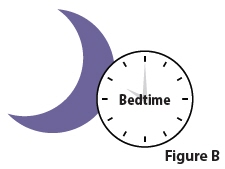
1.2 Before applying SOFDRA make sure that you:
 Do Notshave your underarms within the last 8 hours,
Do Notshave your underarms within the last 8 hours,
 Do Notapply deodorant to your underarms within the last 8 hours,
Do Notapply deodorant to your underarms within the last 8 hours,
 Do Notexercise within the last 30 minutes, and
Do Notexercise within the last 30 minutes, and
 Do Notshower or wash your underarms within the last 30 minutes.
Do Notshower or wash your underarms within the last 30 minutes.
2 Gather supplies
2.1 Gather the following supplies.
-
SOFDRA(Figure C)
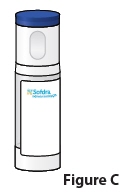
-
Clean towel(Figure D)
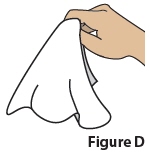
3 Check the expiration date
3.1 Check the expiration date("EXP") on the Bottle label to make sure it has not passed (Figure E).
Do notuse SOFDRA if the expiration date has passed. 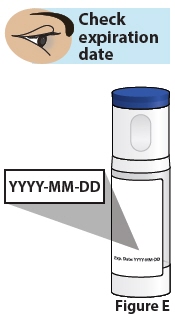
4 Remove Blue Cap and Applicator from Bottle
4.1 Pullthe Blue Cap straight offthe Bottle and set it aside (Figure F).
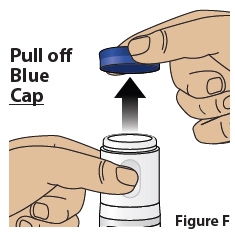
4.2 Pullthe gel Applicator straight offthe Bottle and set it aside (Figure G).
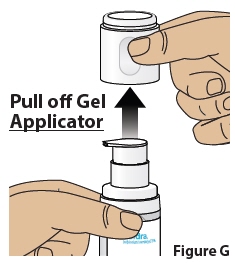

5 Prime the pump(First time use only)
Important:Priming the pump is required the first time you use a new Bottle. The purpose of priming is to make sure the pump works correctly and dispenses gel properly. 5.1 Hold the Bottle over a sink.Press the pump all the way down 1 to 2 times, or until you see gel coming out (Figure H). 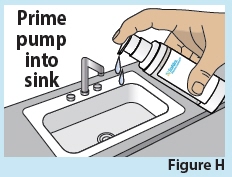
5.2Use water to wash down any gel in the sink(Figure I). 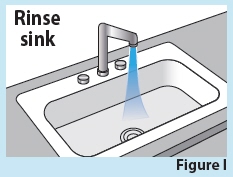
Do nottouch or use any of the gel residue from the sink. 6 Prepare underarms
6.1 Remove all clothing around both underarms(Figure J).
Note:It is okay to use SOFDRA on underarms with hair or new growth (stubble).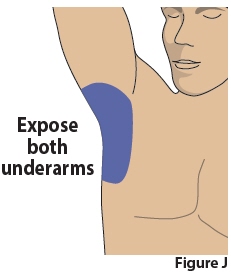
Do notapply SOFDRA to any other part of the body
Do notapply SOFDRA to broken skin.
6.2 Dry both underarms with a clean towelbefore applying SOFDRA gel (Figure K).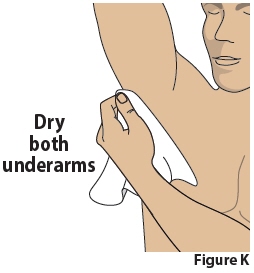
Apply 1 Pump of SOFDRA to Each Armpit
7 Apply 1 pump of SOFDRA gel to first underarm
7.1 Hold the Applicator steady and levelwith the top (flat area) pointing up (Figure L).
Put 1 full pump of gel onto the top of the Applicator(Figure L).
Avoidtouching the gel with your hands or fingers.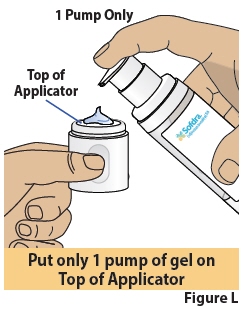
Do notapply more than 1 pump per underarm, regardless of size.
Do nottilt the Applicator until you apply it to your underarm to avoid spilling the gel.
Do notput the gel inside of the opening at the bottom of the Applicator.
7.2 Spread SOFDRA gel around the whole area of the first underarmusing the Applicator (Figure M).
Alwaysapply and spread SOFDRA gel using the provided Applicator.
Do notspread gel with your hands or with a towel.
Do nottouch your underarms after applying the gel.8 Apply 1 pump of SOFDRA gel to second underarm
8.1 Hold the Applicator steady and levelwith the top (flat area) pointing up (Figure N).
Put 1 full pump of gel onto the top of the Applicator(Figure N).
Avoidtouching the gel with your hands or fingers.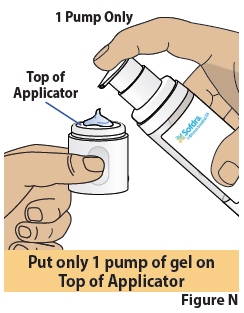
Do notapply more than 1 pump per underarm, regardless of size.
Do nottilt the Applicator until you apply it to your underarm to avoid spilling the gel.
Do notput the gel inside of the opening at the bottom of the Applicator.
8.2 Spread SOFDRA gel around the whole area of the second underarmusing the Applicator (Figure O).
Alwaysapply and spread SOFDRA gel using the provided Applicator. Do notspread gel with your hands or with a towel.
Do nottouch your underarms after applying the gel.9 Let SOFDRA gel dry
9.1 Let SOFDRA gel dry for 5 minutesafter it is applied (Figure P). Keep clothing off the area while it dries.
Note:It is okay to put your arms down.Do notput on clothing until gel has dried completely.
Do notsmoke or go near an open flame until the gel is dry.
SOFDRA gel is flammable.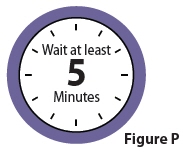
What to do After Applying SOFDRA
10 Rinse and dry Applicator
10.1 Rinse off the Applicator with water(Figure Q).
Avoidtouching the gel with your hands or fingers.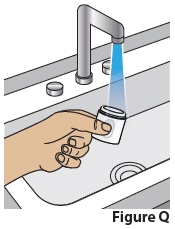
10.2 Pat the Applicator dry(Figure R).

11 Wash hands
11.1 Always wash your hands with soap and water right away after applying SOFDRA gelto avoid spreading any gel residue to any other parts of your body (Figure S).
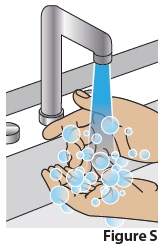
12 Reassemble and store SOFDRA after use
12.1 Push the Applicator straightonto the Bottle, over the pump (Figure T). 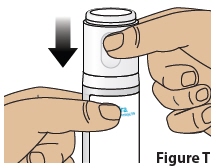
12.2 Push the Blue Cap straightonto the top of the Applicator (Figure U). 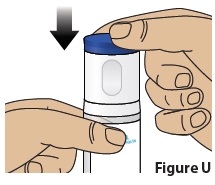
13 Keep SOFDRA on skin for at least 8 hours
13.1 Wait at least 8 hoursafter applying SOFDRA before you shower or wash your underarms (Figure W).
Do notshower or wash your underarms for at least 8 hours after applying SOFDRA. 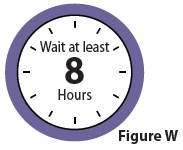
Storage Information Store SOFDRA upright at room temperature between68°F to 77°F (20°C to 25°C) (Figure X) Keep SOFDRA and all medicines out of reach of children. 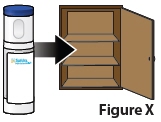
Disposal Information After applying 30 daily doses of SOFDRA gel(Figure Y), throw away the Blue Cap, Applicator, and Bottle into the household trash. 
Additional Information For additional information about how to apply SOFDRA, go to www.sofdra.com or call 1-866-763-6337 Manufactured For:
Botanix SB Inc.
Phoenix, AZ 85016SOFDRA™ is a trademark of Botanix SB Inc. This Instructions for Use has been approved by the U.S. Food and Drug Administration.
Issued: 07/2025 -
PRINCIPAL DISPLAY PANEL - 50 mL Bottle Carton
NDC 83723-010-50
Rx OnlySofdra ™
(sofpironium) topical gel, 12.45%For topical use only.
Apply before bed.
Wash hands with soap and
water immediately after use.STOP
You MUST read
the Instructions
for UseEach pump actuation delivers
0.67 mL of gel containing 72 mg
of sofpironium.Net quantity
50 mL multi-dose metered
pump capable of dispensing 60
pump actuations.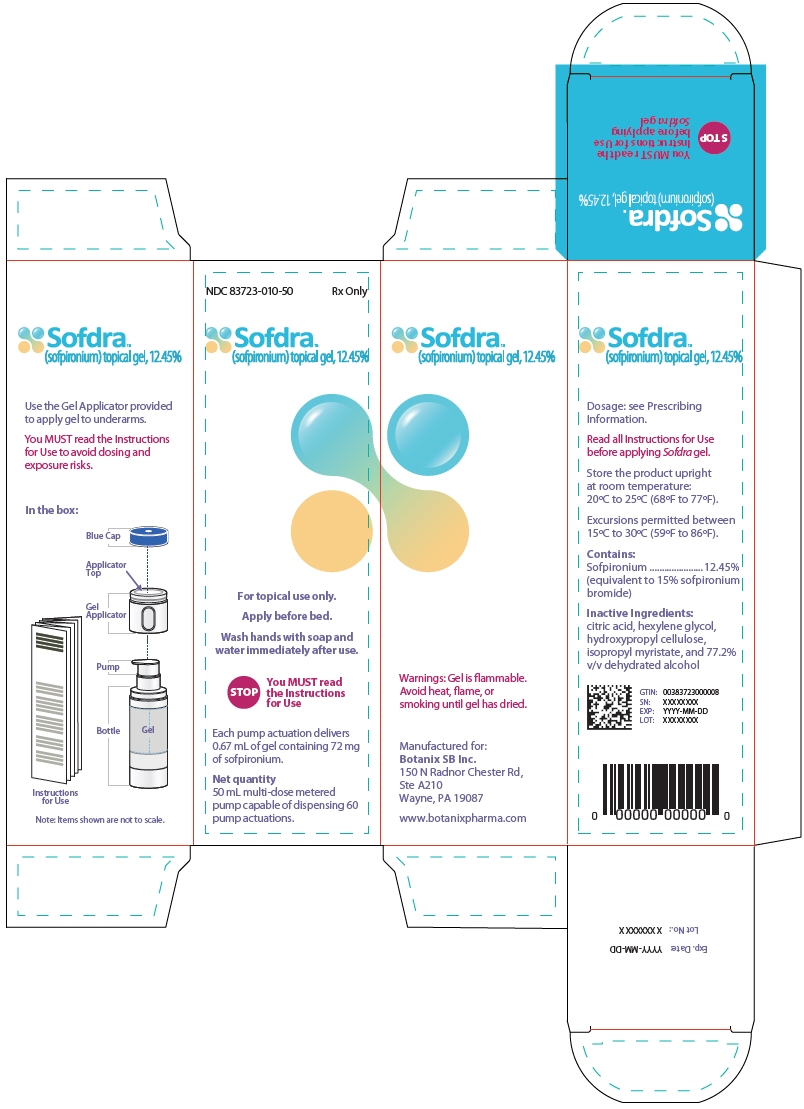
-
INGREDIENTS AND APPEARANCE
SOFDRA
sofpironium bromide gelProduct Information Product Type HUMAN PRESCRIPTION DRUG Item Code (Source) NDC:83723-010 Route of Administration TOPICAL Active Ingredient/Active Moiety Ingredient Name Basis of Strength Strength SOFPIRONIUM BROMIDE (UNII: 7B2Y1932XU) (SOFPIRONIUM BROMIDE - UNII:7B2Y1932XU) SOFPIRONIUM BROMIDE 87 mg in 0.67 mL Inactive Ingredients Ingredient Name Strength HEXYLENE GLYCOL (UNII: KEH0A3F75J) ISOPROPYL MYRISTATE (UNII: 0RE8K4LNJS) HYDROXYPROPYL CELLULOSE, UNSPECIFIED (UNII: 9XZ8H6N6OH) CITRIC ACID MONOHYDRATE (UNII: 2968PHW8QP) ALCOHOL (UNII: 3K9958V90M) Packaging # Item Code Package Description Marketing Start Date Marketing End Date 1 NDC:83723-010-50 1 in 1 CARTON 08/06/2024 1 50 mL in 1 BOTTLE; Type 2: Prefilled Drug Delivery Device/System (syringe, patch, etc.) Marketing Information Marketing Category Application Number or Monograph Citation Marketing Start Date Marketing End Date NDA NDA217347 08/06/2024 Labeler - Botanix SB Inc. (118728574)

